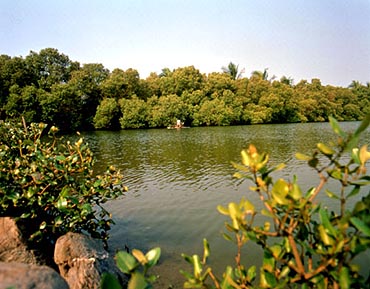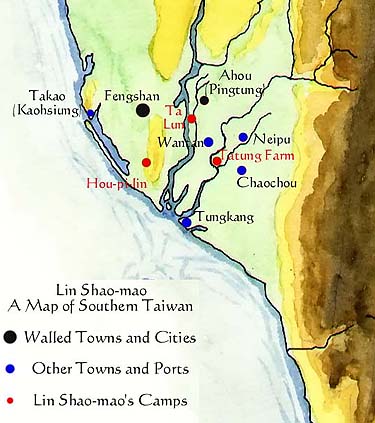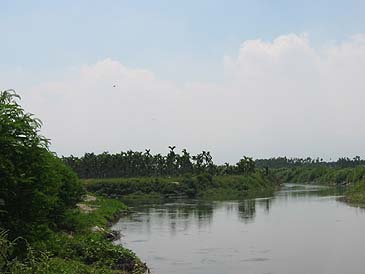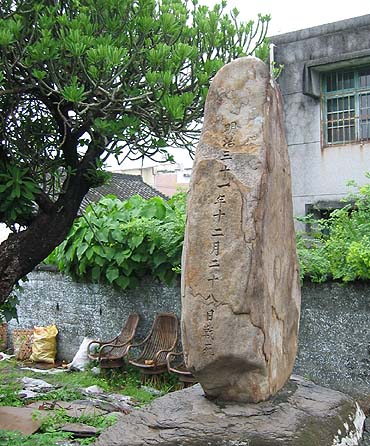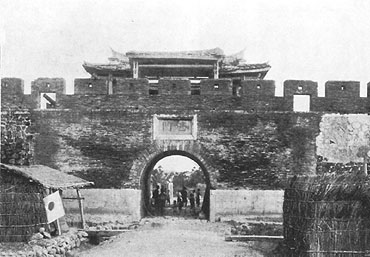|
|||||||
|
|||||||
| Lin’s
Leadership
Lin Shao-mao may have retreated in the face of the Japanese at the end of 1895 and lost his leader Liu Yung-fu, but he regrouped and rebuilt his forces over the next years, taking advantage of the abundant supply of plucky young males. At that time there were an immense amount of single males, who had come over from the mainland in earlier years as casual agricultural labourers, that offered a vast pool of disaffected and idle manpower who could readily be enlisted to any cause or purpose. His first recorded independent attack took place in the spring of 1896, when he led just 60 men to ambush a detachment of Japanese troops travelling from Fengshan to Chao-chou. His men killed '6 or 7 soldiers' which gained him standing with the local populace. On 10 June 1896 he led his men on a more ambitious assault on the A-hou Military Police Office. Although he was able to cut off all external communications, his fighters were unable to press home their advantage and fell back. Lin Shao-mao attributed this to his lack of modern weaponry and promptly devised a mission to Xiamen (Amoy) to obtain arms. |
|||||||
In August 1896 he was able to smuggle in an arms shipment through 'Nan-kang', which is most probably today's Ta-peng-wan (Ta-peng Bay) south of Nan-chou and beside Tung-kang [ 東港鎮 ]. Ta-peng Bay (pictured on the right), is the largest natural lagoon in Taiwan and has a myriad of little inlets surrounded by mangroves (Avicennia marina) that still make some areas almost impenetrable. After setting his wife up near A-li-kang (today's Li-kang [ 里港鄉 ]) village, he led his men to reconnoitre the towns of Tung-kang, Fang-liao and Wan-tan, resulting in a series of small scale attacks. with numerous Japanese casualties, including a Japanese police chief. |
Mangrove inlets at the lagoon of Ta-peng Bay |
||||||
|
Such tales of
daring enabled Lin Shao-mao to gain a greater reputation and by
consequence both recruit more fighters and form alliances with more
like-minded 'rebel' bands.
Over the next few months he was able to recruit some 400 additional fighters. |
NOTE: The Japanese later made the whole lagoon a military area, building a railway close to the lagoon shore thus defeating further any smuggling episodes. The military area, which was used as a sea-plane base by the Japanese and later became the Pingtung Military Training Centre under the Kuomintang, has recently been given back to the nation in 1997 and is now being promoted as a tourist scenic area albeit with extensive development plans. | ||||||
|
Detail of map of southern Taiwan in Lin Shao-mao's time |
Despite Lin Shao-mao’s weapons being very old, he trained his men to shoot accurately and had an efficient command structure. Lin was also particularly successful in recruiting and combining the disparate forces of the aborigines, the Hakka and the Min-nan from across the Kaoping, or southwestern Taiwan, plains. Moreover he also had the crucial advantage over the Japanese of being familiar with the terrain. As a result the Japanese authorities viewed him as the principal ‘bandit’ (rebel) threat in the south of the island: the other main leaders being Chien Ta-shih in the north and Ke Tieh-hu in the centre. With Lin Shao-mao now leader of a sizable force and with a formidable reputation he now launched a series of spiralling attacks: |
||||||
|
Next, on 13 September 1897, he attacked the police barracks at A-hou (Pingtung). Then, in December 1897, he attacked the Nei-pu [ 內埔鄉 ] Police Office ‘killing many police’. On 23 April of the following year of 1898, Lin Shao-mao led over 200 men in another assault on Tungkang. Yet it was to be in December 1898 that Lin Shao-mao was to carve out his place in Taiwan history. |
|||||||
|
|
|||||||
| The
December 1898 Rebellion
On 18 December 1898 Lin Shao-mao led 200 men in an assault on the North Gate of A-hou that was coordinated with simultaneous assaults on the other gates by various 'rebel' bands. 'Many Japanese died' within the four hours of fierce fighting, but the insurgents were unable to enter A-hou. Japanese reinforcements sent from Wan-tan were ambushed midway by another band led by Huang Wen-hsing. A second group of reinforcements, comprising three units of troops and military police, was then sent from Feng-shan. Upon nearing Chao-chou late on the evening of 19 December 1898, these troops were assailed by Lin Shao-mao, and, after two hours of fighting, found themselves almost surrounded and thus were forced to withdraw into the mountains to regroup. |
|||||||
|
The confluence of the Ai-liao and Tung-kang rivers below Ta-tung Farm |
Lin Shao-mao regrouped his forces in the area of
Chu-tien, a few miles west of Chao-chou, where he had another of his bases. This base was situated on a
narrow neck of land between the Ai-liao and Tung-kang Rivers which converge
southeast of Wan-tan. This seems
typical of Lin's bases where an intimate knowledge of the terrain would
be necessary to make an approach, yet which allowed Lin many avenues for
escape.
From the base he assembled a coalition force of over 2000 fighters to take advantage of the Japanese disarray. The force would include 700 Paiwan braves, and Hakka forces led by Lin Tien-fu, for whom the Japanese had a particular fear. |
||||||
|
NOTE: This base was
subsequently taken
over by the Japanese government's Taiwan Development Corporation as an
agricultural station, which is
today called the Fengshan Ta-tung Farm [
大同農場
] and lies just across
the Ai-liao River from Hsing-hua village southeast of Wantan. In 1922 a subsidiary of the Taiwan Development Corporation, Hoshi Seiyaku KK, planted cinchona trees at the station in order to produce quinine, often known as 'Jesuit fever bark', the drug used to counter malaria which had ironically caused far more casualties to the Japanese forces than any rebel leader. Indeed, Davidson records some 4,624 as dying from disease (principally malaria) yet only 164 being killed in battle prior to 1898. Interestingly the same company, Hoshi Seiyaku, also had coca plantations in Chia-yi County for the production of cocaine. |
|||||||
|
|
|||||||
|
The Attack on Chao-chou On 28 December
1898 Lin Shao-mao led the overwhelming force of over
2,000 men in a massive and definitive attack on Chao-chou. |
|||||||
|
Memorial to the Japanese police officers slain at Cha-chou |
The Japanese forces in
Chao-chou were duly overwhelmed. The chief of the Japanese Government
Office in Chao-chou, Mr Seto, was subsequently beheaded and, according to Japanese sources,
‘his ribs removed’. Police reinforcements were rapidly sent from Wantan but their
chief was also seized and slain.
The slain officers were buried within the police barracks at Chao-chou although the remains were subsequently removed. The resulting memorial can still be seen within the compound at Chao-chou (see photograph at left). The inscription on the side of the stone (shown left) records the date of the attack as the 31st year of Meiji Period (1898), 12 month (December), 28th day. The inscription on the front (not shown) reads 'Deceased Tainan Prefecture Police Inspector Kodomatsu Jiro Memorial'. The character reading 'memorial' was inserted to replace the original character signifying 'grave' when the remains were removed. |
||||||
|
Lin Shao-mao and his coalition forces next moved rapidly south to lay siege, on 29 December 1898, to the Japanese Army barracks in the walled city of Heng-chun [ 恆春鄉 ] (Hengchun). Once again Lin found that a walled city, though easy to isolate, was extremely difficult to break into when defended by modern Japanese weaponry. The Japanese troops trapped inside Hengchun tried to break out from the siege but the rebels commanded all the strategic points around Heng-chun. Southern Taiwan was now in open rebellion against the Japanese. |
Heng-chun West Gate around 1900 |
||||||
|
|
|||||||
|
The surprising Japanese responses and the inevitable end result are described on the next pages. |
|||||||
|
|||||||
|
|||||||
